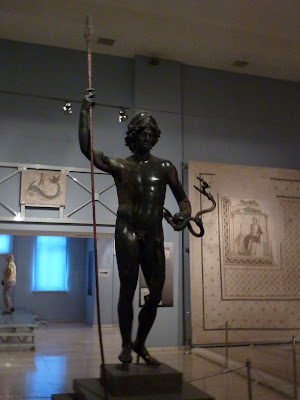But the best reason for visiting Gaziantep is its archaeological museum. When, due to modern dam construction, the waters of the Euphrates began to rise, rescue archaeology financed by the American David Packard focused on the Roman city of Zeugma, and, consequently, some of the best and most intact mosaics ever found were saved. These mosaics now reside in the museum at Gaziantep.
Important PS: also in Gaziantep we found the wonderful Koluman Motorlu Araclar Ticaret ve Sanayi A. S., the local Mercedes Benz dealer, and a manager there who spoke excellent English, and had our engine oil/filters/etc., changed. Total cost was about $300. Compare this with $700 in Lisbon and $800 in Goteborg. So, we have resolved that, next time we need an oil change in Sweden, we will drive straightaway to Turkey.
 |
In the Gaziantep Archaeology Museum; we have seen this
pose before: Antiochos and Heracles, close personal buds
|
 |
Closer up of a huge mosaic, the river god Okeanos and his wife Tethys, in a shallow
pool of a Roman villa at Zeugma, 2nd century
|
 |
Detail; vibrant colors, not a tile missing
|
 |
Another room, showing the scale of this stuff
|
 |
Another; all these were floor mosaics
|
 |
Central panel of Euphrates River God mosaic, in a large room
|
 |
Geometrical
|
 |
Bronze Mars, found in an over-sized
amphora jar in Zeugma
|
 |
Zeugma as it appeared in the "rescue"
|
 |
What everyone comes to see is "the Gipsy Girl," a mosaic fragment often
compared with the Mona Lisa; the signage here tells you she is not in the mosaic
display area, but rather in the archaeology section (where, presumably, security is
better)
|
 |
And there she is
|

























































